Blue Bird has delivered in California its 1,500th electric school bus
Blue Bird has delivered its 1,500th electric, zero-emission school bus to Modesto City Schools in California. Blue Bird recently celebrated the grand opening of its Electric Vehicle (EV) Build-up Center in Georgia, which will enable the company to increase its long-term production capacity to 5,000 electric school buses a year. Blue Bird’s zero-emission school buses […]

Blue Bird has delivered its 1,500th electric, zero-emission school bus to Modesto City Schools in California.
Blue Bird recently celebrated the grand opening of its Electric Vehicle (EV) Build-up Center in Georgia, which will enable the company to increase its long-term production capacity to 5,000 electric school buses a year. Blue Bird’s zero-emission school buses are powered by the electric PowerDrive 7000 system from Accelera by Cummins, which is a result of their long-standing collaboration on technology innovation.
1,500 electric school buses delivered by Blue Bird
Modesto City School purchased its advanced electric vehicles through Blue Bird’s authorized school bus dealer A-Z Bus Sales in California.
Modesto’s milestone unit is now one of 1,500 Blue Bird electric school buses serving school districts across 41 U.S. states, the OEM says. And adds: “Replacing 1,500 diesel-powered and polluting school buses with an equal number of zero-emission vehicles reduces harmful carbon emissions by nearly 16,000 metric tons annually. In addition, more than 110,000 students a day are no longer exposed to diesel tailpipe emissions linked to serious health issues such as asthma or heart disease”.
“Blue Bird is recognized as the technology leader and innovator of low- and zero-emission school buses. We are proud to celebrate this major milestone – an industry first – with Modesto City Schools and all our valued customers across North America. In addition, we are thankful to our amazing employees, dealers, and suppliers for contributing every day to our joint success,” said Britton Smith, president at Blue Bird Corporation. “The demand for clean and sustainable school bus transportation remains high. Therefore, Blue Bird continues to significantly expand its electric school bus production.”
“The completion of our fleet of electric buses is just one of many steps we are taking toward environmental sustainability at Modesto City Schools,” said Dr. Sara Noguchi, superintendent of Modesto City Schools. “This project speaks to the impact that any district can choose to have – by committing to environmental sustainability and prioritizing dollars and effort toward that goal.”







